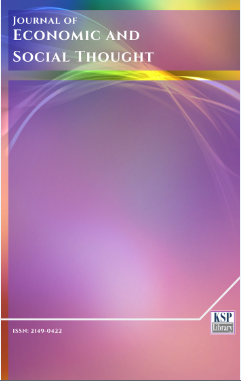The Postulate of the Three Regimes of Economic Growth Contradicted by Data
Abstract
Abstract. Economic growth in Western Europe, Eastern Europe, Asia, countries of the former USSR, Africa and Latin America were analysed. It is demonstrated that the fundamental postulate of the Unified Growth Theory about the existence of the three regimes of growth (Malthusian regime, post-Malthusian regime and sustained-growth regime) is contradicted by data. These regimes did not exist. In particular, there was no escape from the Malthusian trap because there was no trap. Economic growth in all these regions was not stagnant but hyperbolic. Unified Growth Theory is fundamentally incorrect. However, this theory is also dangerously misleading because it claimsa transition from the endless epoch of stagnation to the new era of sustained economic growth, the interpretation creating the sense of security and a promise of prosperity. The data show that the opposite is true. Economic growth in the past was sustained and secure. Now, it is supportedby the increasing ecological deficit. The long-term sustained and secure economic growth has yet to be created. It did not happen automatically, as suggested incorrectly by the Unified Growth Theory.
Keywords. Regional economic growth, Gross Domestic Product, Unified Growth Theory, Malthusian stagnation, post-Malthusian regime, sustained-growth regime, Industrial Revolution, hyperbolic growth.
JEL. A10, C12, C20, F00, N00, O10.Keywords
References
Artzrouni, M., &Komlos, J. (1985). Population Growth through History and the Escape from the Malthusian Trap: A Homeostatic Simulation Model. Genus, 41(3-4), 21-39.
Ashraf, Q.H. (2009). Essays on Deep Determinants of Comparative Economic Development.Ph.D. Thesis, Department of Economics, Brown University, Providence.
Bangla News, (2015). Bangladesh Chairmen of Least Developed Countries.http://www.en.banglanews24.com/fullnews/bn/115940.html
BBC, (2014).The North South Divide.http://www.bbc.co.uk/bitesize/standard/geography/international_issues/contrasts_development/revision/2/
Bethell, L. (1984). The Cambridge History of Latin America: Vol. I and II, Colonial Latin America. Cambridge, UK: Cambridge University Press.
Floud, D. & McCloskey, D.N. (1994).The Economic History of Britain since 1700. Cambridge: Cambridge University Press.
Galor, O. (2005a). From stagnation to growth: Unified Growth Theory. In P. Aghion& S. Durlauf (Eds.), Handbook of Economic Growth (pp. 171-293). Amsterdam: Elsevier.
Galor, O. (2005b). The Demographic Transition and the Emergence of Sustained Economic Growth.Journal of the European Economic Association, 3(3), 494-504. doi. 10.1162/jeea.2005.3.2-3.494
Galor, O. (2008a). Comparative Economic Development: Insight from Unified Growth Theory. http://www.econ.brown.edu/faculty/Oded_Galor/pdf/Klien%20lecture.pdf
Galor, O. (2008b). Economic Growth in the Very Long Run. In: Durlauf, S.N. and Blume, L.E., Eds., The New Palgrave Dictionary of Economics, Palgrave Macmillan, New York. doi. 10.1057/9780230226203.0434
Galor, O. (2010). The 2008 Lawrence R. Klein Lecture—Comparative Economic Development: Insights from Unified Growth Theory. International Economic Review, 51(1), 1-44. doi. 10.1111/j.1468-2354.2009.00569.x
Galor, O. (2011). Unified Growth Theory.Princeton, New Jersey: Princeton University Press.
Galor, O. (2012a). Unified Growth Theory and Comparative Economic Development. http://www.biu.ac.il/soc/ec/students/mini_courses/6_12/data/UGT-Luxembourg.pdf
Galor, O. (2012b). The Demographic Transition: Causes and Consequences. Cliometrica, 6(1), 1-28. doi. 10.1007/s11698-011-0062-7
Galor, O. (2012c). Unified Growth Theory and Comparative Economic Development. http://www.biu.ac.il/soc/ec/students/mini_courses/6_12/data/UGT-Luxembourg.pdf
Galor, O., &Moav, O. (2002). Natural Selection and the Origin of Economic Growth.The Quarterly Journal of Economics, 117, 1133-1191. doi. 10.1162/003355302320935007
Kapitza, S.P. (2006). Global population blow-up and after. Hamburg: Global Marshall Plan Initiative.
Komlos, J.H. (1989). Thinking about Industrial Revolution.Journal of European Economic History,18, 191-206.
Lagerlöf, N-P. (2006). TheGalor-Weil Model Revisited: A Quantitative Exercise. Review of Economic Dynamics, 9(1), 116-142.doi. 10.1016/j.red.2005.07.002
Lee, R.D. (1997). Population dynamics: equilibrium, disequilibrium, and consequences of fluctuations. In O. Stark & M. Rosenzweig (Eds.), The Handbook of Population and Family Economics (pp.1063-1115). Amsterdam: Elsevier.
Maddison, A. (2001). The World Economy: A Millennial Perspective. Paris: OECD.
Maddison, A. (2010). Historical Statistics of the World Economy: 1-2008 AD. http://www.ggdc.net/maddison/Historical Statistics/horizontal-file_02-2010.xls.
McKeown, T. (2009). The Epidemiologic Transition: Changing Patterns of Mortality and Population Dynamics. American Journal of Lifestyle Medicine, 3(1), 19S-26S.doi. 10.1177/1559827609335350
Nielsen, R.W. (2014). Changing the Paradigm.Applied Mathematics, 5, 1950-1963.doi. 10.4236/am.2014.513188
Nielsen, R.W. (2015a). The Insecure Future of the World Economic Growth.Journal of Economic and Social Thought, 2(4), 242-255.
Nielsen, R.W. (2015b). Unified Growth Theory Contradicted by the GDP/cap Data.http://arxiv.org/ftp/arxiv/papers/1511/1511.09323.pdf
Nielsen, R.W. (2016a). Mathematical Analysis of the Historical Economic Growth.Journal of Economic Library, 3(1), 1-11.
Nielsen, R. W. (2016b). Unified Growth Theory Contradicted by the Mathematical Analysis of the Historical Growth of Human Population. http://arxiv.org/ftp/arxiv/papers/1601/1601.07291.pdf
Nielsen, R. W. (2016c). Hyperbolic Growth of the World Population and Its Link to the Economic Growth. Turkish Economic Review, 3(1), 16-27
Pereira, E. (2011). Developing Countries Will Lead Global Growth in 2011, Says World Bank.
Snowdon, B., &Galor, O. (2008).Towards a Unified Theory of Economic Growth.World Economics, 9, 97-151.
UNCTAD, (2013). Map of the LDCs. http://unctad.org/en/Pages/ALDC/Least%20Developed%20Countries/LDC-Map.aspx
UNDATA, (2015), Western Sahara.http://data.un.org/CountryProfile.aspx?crName=Western%20Sahara
van de Kaa, D.J. (2008). Demographic Transition.In Y. Zeng (Ed.).DemographyEncyclopedia of Life Support Systems.Vol. 2. Paris: UNESCO.
Weaver, T.D., Roseman, C.C., & Stringer C.B. (2008). Close correspondence between quantitative and molecular-genetic divergence times for Neanderthals and modern humans. Proceedings of the National Academy of Sciences of the United States of America, 105, 4645-4649.
WWF, (2010).Living Planet Report 2010: Biodiversity, biocapacity and development. Gland, Switzerland: WWF International.
DOI: http://dx.doi.org/10.1453/jest.v3i1.669
Refbacks
- There are currently no refbacks.
Journal of Economic and Social Thought - J. Econ. Soc. Thoug. - JEST - www.kspjournals.org
ISSN: 2149-0422
Editor: [email protected] Secretarial: [email protected] Istanbul - Turkey.
Copyright © KSP Library




